New UN population projections: Where are we headed?
The United Nations recently published a new set of world population estimates and projections. According to the UN demographers, we are still on track for a peak of more than…
Read More
Written by Olivia Nater | Published: July 7, 2025
World Population Day, July 11, is the international observance day dedicated to raising awareness of population-related issues. But how much does the average American really know about population sizes and trends, are they concerned about them, and if so, why? We conducted a survey to find out.
Declining fertility rates in the Global North have become the dominant population story in the media, with daily headlines proclaiming a “baby bust” or “fertility crisis,” or even predicting “population collapse.” At Population Connection, we wanted to find out to what extent this rhetoric is shaping public knowledge and perception of demographic trends.
In June 2025, we worked with polling firm YouGov to launch an online survey of a representative sample of 2,000 US adults. We asked people 10 simple questions about the national population, the global population, their exposure to population-related headlines, and their concerns (if any) related to declining birthrates and global population growth.
Survey respondents were asked to guess the sizes of the US and the global populations. Guesses spanned an enormous range, from a few thousand to many trillions(!) for both the US population (which actually stands at around 342 million) and the global population (which is around 8.2 billion). Of course, there is no way of knowing for sure whether everyone made serious guesses, but presumably those who have a rough idea of the correct population size did make their best guess.
Out of the 2,000 respondents, only 16% made “correct or very close”[1] guesses that were within 5% of the actual US population (in other words, between 325 and 359 million), and 20% made “correct or very close” guesses that were within 5% of the global population (between 7.8 and 8.6 billion).
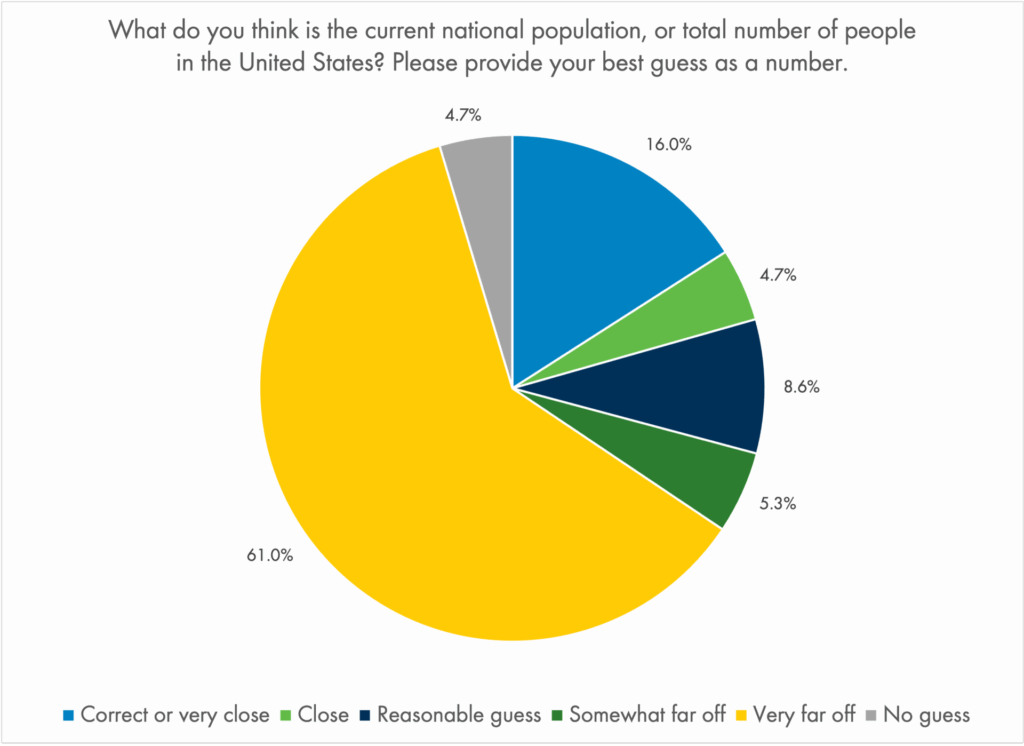
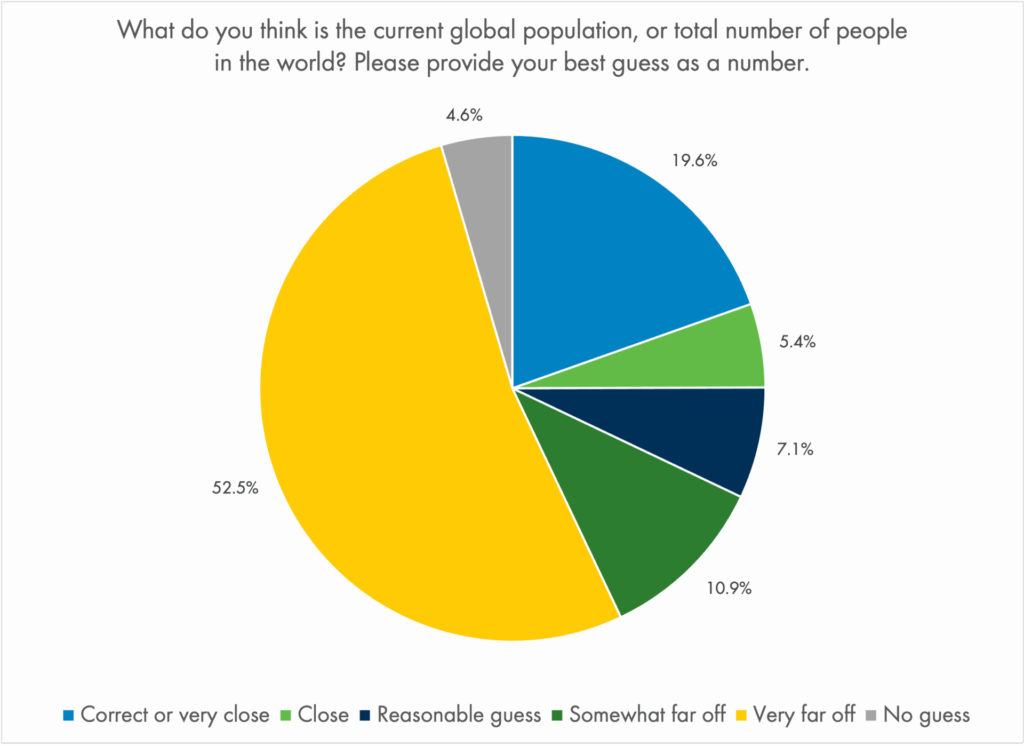
For both population sizes, the majority of respondents made guesses that were “very far off,” guessing a population size more than 50% higher or lower than the actual population. For the national population, as many as 61% of respondents were “very far off,” while for the global population, 53% were “very far off.”
This and the fact that many guesses were incorrect by several orders of magnitude indicate that Americans are generally poorly informed about demographics, surprisingly in particular regarding their own national population, and that many struggle to conceptualize very large numbers.
When asked whether the US population is growing, shrinking, or staying the same, just 61% knew it is growing, while 21% said they believe it’s shrinking, and 18% said they believe it’s staying the same.
Knowledge was slightly better regarding the global population, with 72% saying it’s growing, 15% believing it’s shrinking, and 14% believing it’s staying the same.
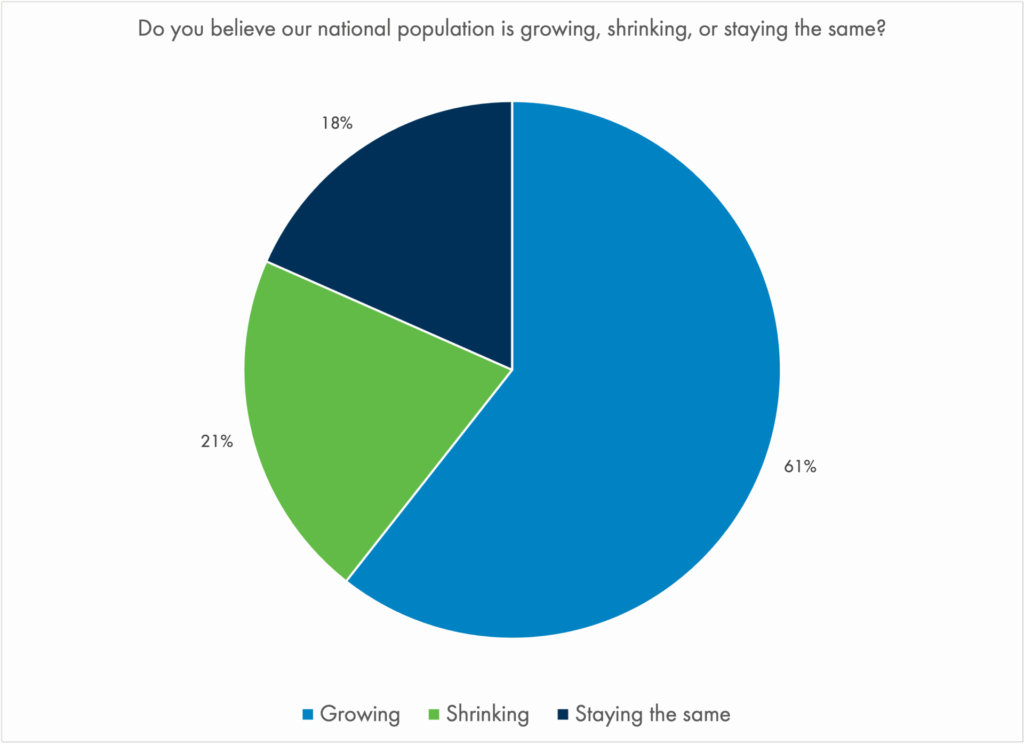
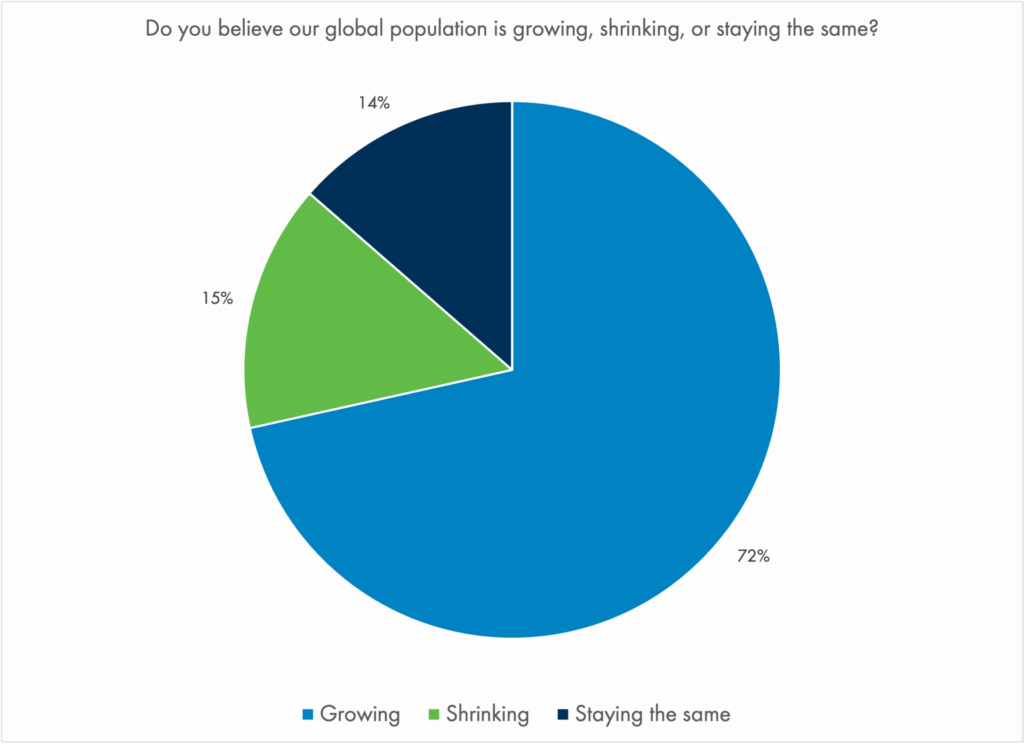
Interestingly, there was a significant gender divide, with a higher proportion of men than women knowing about population growth (65% of men vs. 56% of women believe the national population is growing, and 78% of men vs. 65% of women believe the global population is growing).
Across age groups, people aged 65 and older had the poorest understanding of the national population trend, with only 56% believing the US population is growing.
When asked if they had seen any headlines about declining birthrates in the past month, close to a third (31%) of survey respondents said yes, while just over one-in-ten (11%) said they had seen headlines about global population growth. This is unsurprising considering the aforementioned dominance of the fertility decline narrative.
For both questions, reported exposure to headlines increased dramatically with education level. For global population growth, just 8% of respondents with high school education or less reported seeing related headlines, vs. 16% of respondents with postgraduate level education.
For declining birthrates, a fifth (20%) of respondents with high school education or less reported seeing headlines, vs. nearly half (49%) of respondents with a postgraduate degree. The 65+ age group had the highest proportion of respondents who reported seeing headlines about declining birthrates (35%), which may explain why so few of them know that the national population is still growing. Declining birthrate headline exposure was higher among men than women, however, so the aforementioned gender divide is hard to explain.
Respondents were also asked how concerned they are about declining birthrates and world population growth.
Only 6% said they are very concerned about declining birthrates, while 18% said they are somewhat concerned, 23% said they are a little concerned, and more than half, 53%, said they are not at all concerned.
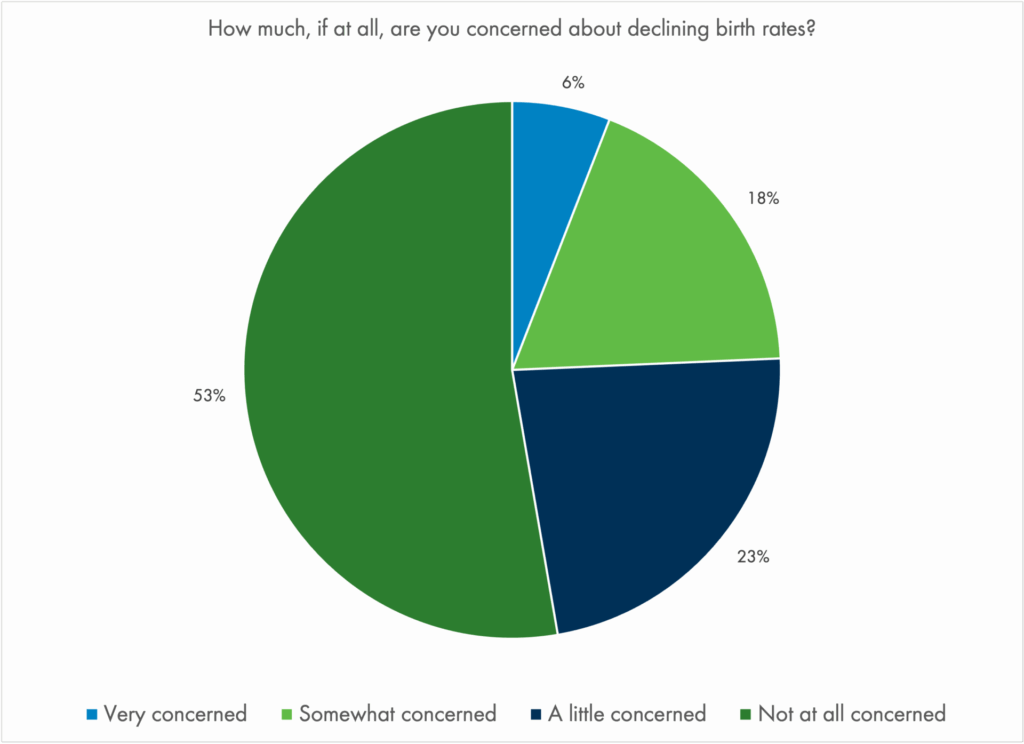
Conservatives reported higher concern about low birthrates than liberals — a third (32%) of conservatives said they were very to somewhat concerned, vs. just 17% of liberals.
Regarding global population growth, 9% said they are very concerned, 24% said they are somewhat concerned, 25% said they are a little concerned, and 42% said they are not at all concerned.
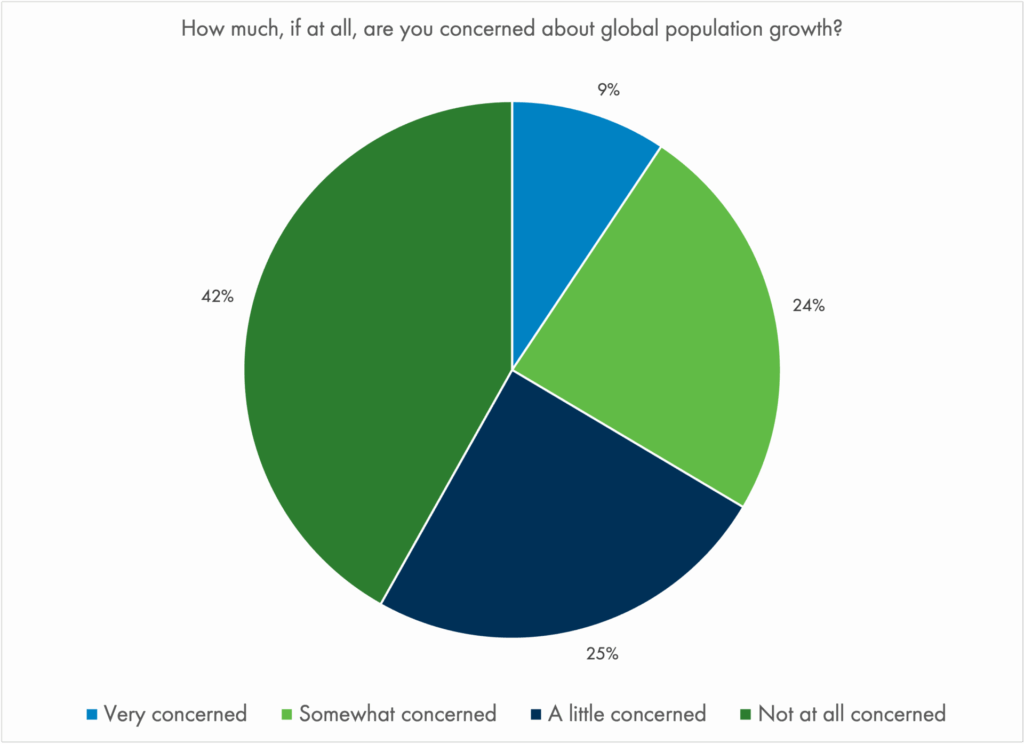
Liberals reported higher concern about global population growth than conservatives (38% of liberals said they were very to somewhat concerned, vs. 28% of conservatives).
Respondents who expressed concern about declining birthrates or global population growth were then asked to select their top three reasons for this concern from a list of options. (Those who said they were not concerned about either issue were not shown this corresponding question.)
For those concerned about low birthrates, by far the biggest reason for concern was “Erosion of traditional family values / fewer people getting married and having children,” with 29% of respondents ranking this as their number one. Surprisingly, this was the number one reason across all age groups, especially among those aged 65 and older, with 35% of them ranking it in first place.
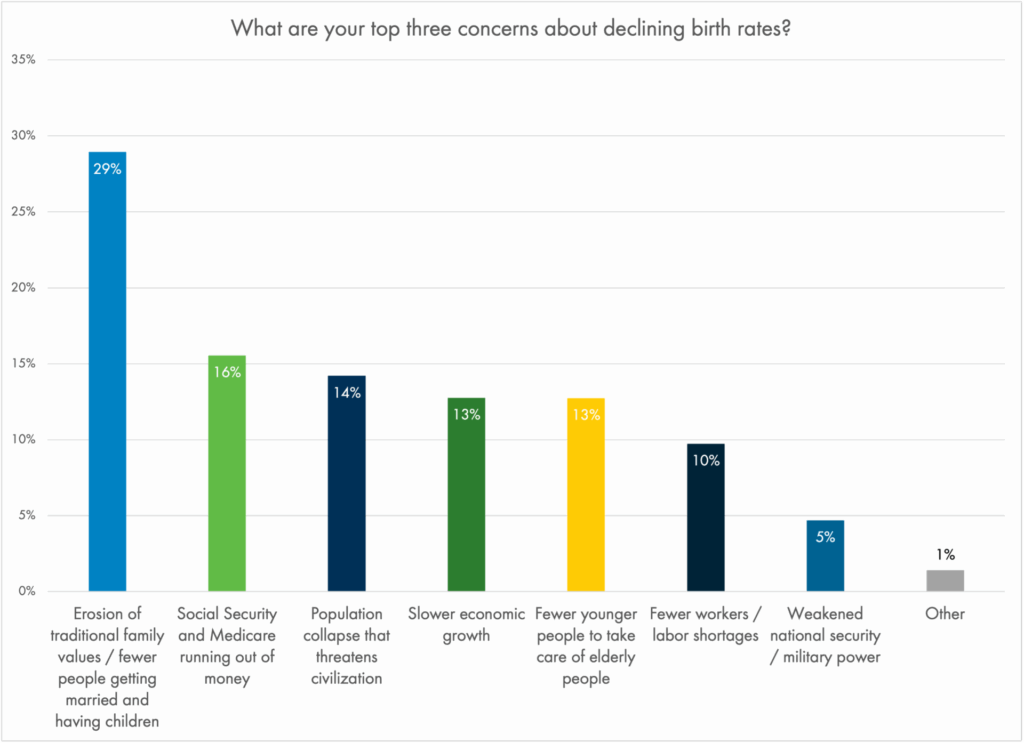
There was a big political gap for the family values reason, with 45% of conservatives selecting this as their top concern, vs. just 10% of liberals. This is not surprising, considering many conservative pronatalists, including those in the Trump administration, blame non-traditional families and feminism for a supposed baby shortage.
Even though “baby bust” media stories almost always focus on economic concerns related to reduced population growth, these were not considered as important by our survey respondents. “Social Security and Medicare running out of money” received the second highest proportion of votes for rank one overall, but this was much lower than for eroding family values, with 16% of all respondents selecting insolvency as their top concern. Among liberals, however, Social Security and Medicare insolvency was the top concern, with almost a quarter (24%) choosing this reason.
The third most popular selection for first place was “Population collapse that threatens civilization,” which is frequently raised by notorious fertility decline alarmist Elon Musk, with 14% of all respondents choosing this as their top concern.
“Slower economic growth” and “fewer workers / labor shortages” were the most popular choice for second place, with 18% and 17%, respectively, choosing these as their second most important concern.
The selection for third place was fairly evenly split between the aforementioned economic concerns, as well as “fewer younger people to take care of elderly people.”
For those who expressed concern about global population growth, almost a quarter (24%) said that “more people living in poverty” was their top concern (which is similar to what we found in our previous survey research on fertility desires and outcomes). This reason was followed closely by “depletion of natural resources,” with 22% selecting this as their number one concern.
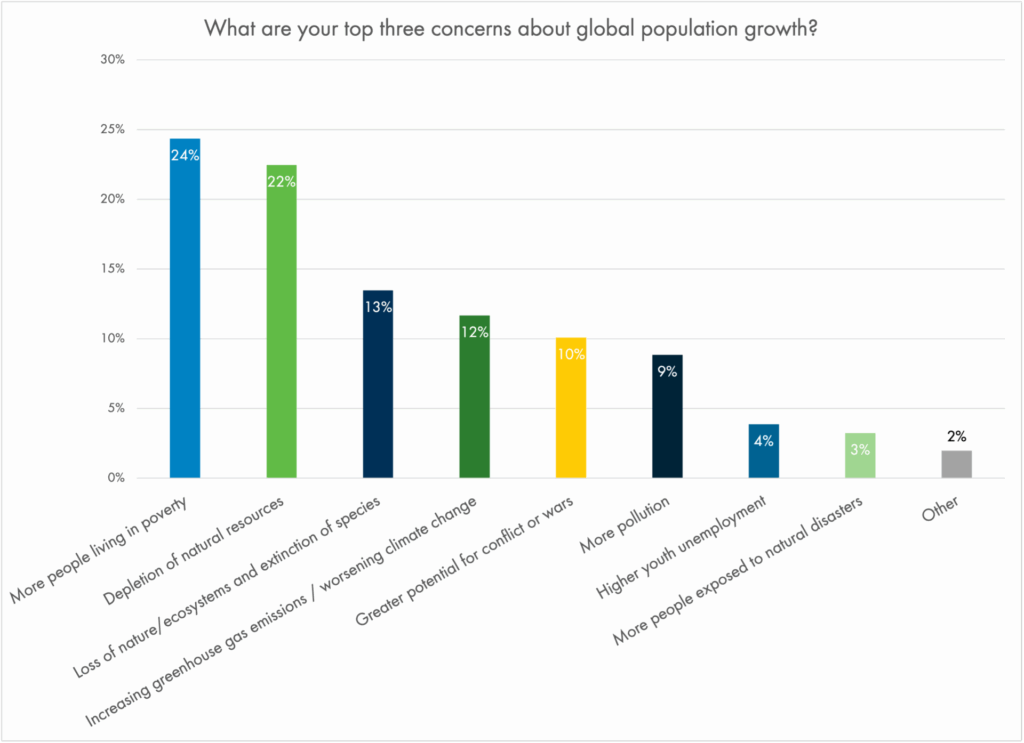
Here too there was a political divide — the top concern for conservatives was more people in poverty (27% chose this as their number one concern), while for liberals, it was “increasing greenhouse gas emissions / worsening climate change” (24% chose this as their number one concern).
More people living in poverty and depletion of resources were also the most selected concerns for second place (19% and 17%, respectively, chose this), followed closely by “loss of nature / ecosystems and extinction of species” (16%). Similarly, more people in poverty and resource depletion received the most votes for third place as well.
Our survey reveals that the general public is ill-informed about population sizes and trends, which is likely being exacerbated by the barrage of media stories about declining fertility rates. Only a third of respondents reported being very to somewhat concerned about global population growth, despite this factor underlying so many of our contemporary environmental crises. However, it was encouraging to see that people are overall still more concerned about global population growth than declining birthrates, which is likely in part due to the fact that the negative impacts of population growth are easily witnessed, while concern over low fertility is still a relatively new phenomenon with largely predicted rather than currently measurable downsides.
There is clearly a need for organizations like Population Connection to continue to push back against “baby bust” misinformation, and to raise awareness of population facts and issues as well as of the urgent necessity to invest in empowering solutions to achieve a more sustainable human population.
Survey questions and toplines results can be downloaded here, and full results tables are available here.
[1] The categorizations in this section were created by our staff, not by YouGov.